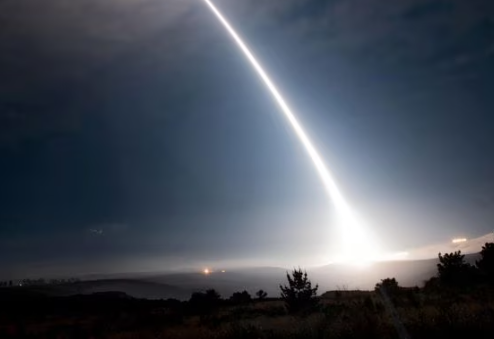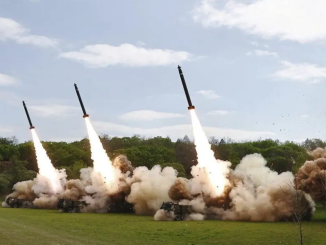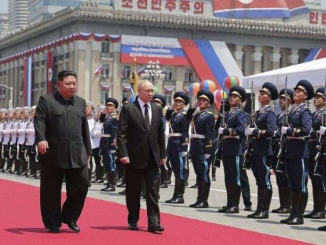
When the Pentagon drew up its plan to spend up to $1.5 trillion over 30 years to rebuild its aging nuclear triad of bombers, missiles, and submarines more than a decade ago, it faced only one serious nuclear competitor: Russia.
Now, a congressionally mandated commission has issued a report warning that with China expanding its nuclear arsenal and declaring a “best friends” relationship with Russia, the U.S. urgently needs the capability to deter, and if necessary defeat, both potential adversaries at the same time.
{snip}
“The U.S. is on the cusp of a fundamentally different global setting for which we did not plan, and for which we are not well prepared. We are facing, confronting if you will, two nuclear peers, and this is unprecedented,” Creedon testified before the Senate Armed Services Committee. “The nation must act now and with a sense of urgency that the commission did not always see.”
The Strategic Posture Commission was established in 2022, and its report coincides with the Pentagon’s annual report to Congress on Chinese military power, which this year includes warnings about China’s increasing provocative acts aimed at intimidating Taiwan and ambitious plans to build long-range ICBMs and expand its nuclear arsenal.
The People’s Republic of China is rapidly modernizing, diversifying, and expanding its nuclear forces well beyond previous projections, Pentagon officials told reporters in a background briefing.
“We estimate that the PRC had, as of May, more than 500 nuclear weapons in its arsenal and is building a larger force that will surpass 1,000 nuclear weapons in 2030,” Michael Chase, deputy assistant secretary of defense for China, told an Atlantic Council forum in late October.
{snip}
China is racing to achieve nuclear parity, while at the same time practicing a range of military options to achieve Chinese President Xi Jinping’s stated goal of forcing the unification of the self-ruled, democratic island of Taiwan with mainland China before the decade is out.
Among the possible courses of action outlined in the Pentagon report are an air and naval blockade to cut Taiwan off from outside contact and force its capitulation, precision missile and air strikes against key government and military targets, and even an amphibious invasion.
If China is not deterred and attacks Taiwan, the U.S. cannot assume Russia will stand by, warns former Arizona Republican Sen. Jon Kyl, vice chairman of the Strategic Posture Commission.
“You can’t ignore the possibility that either in concert or perhaps simply because one of those two countries has started something with us, the other sees an opportunity to pursue its goals also militarily,” Kyl said in Senate committee testimony. “Because we’re dealing with two nuclear powers here, and we’ve got to prevent nuclear war. Deterrence is what this is all about.”
The commission report comes to the stark conclusion that the Pentagon’s decadeslong plan to rebuild all three legs of the nuclear triad from scratch will not produce forces sufficient to deter, or counter, Russian and Chinese nuclear threats simultaneously.
{snip}
“It was clear that we have a new threat for the first time in our history, we possibly face two nuclear peers,” Kyl said in his Senate testimony. “For the Russians, they’ve already, pretty much, completed their modernization. They’re almost done. Chinese are well on the way toward achieving their military buildup, and … the United States has barely begun.”
“We’re undertaking a lengthy process of extending the life of our nuclear warheads, of developing three entirely new delivery-type vehicles for the triad,” Kyl said. “And to get all of that done in time and change out what we have for these new weapons and delivery systems on the schedule that have been set forth is going to be exceedingly difficult.”
“As unpleasant as it may be, Congress and the administration should assume that the new systems will be late and probably over budget,” Creedon testified. “Unfortunately, there is a growing risk of confrontation with China, Russia, or both. This includes the risk of military conflict, including the possibility of nuclear use.”
The most recent report from the Congressional Budget Office projects the cost of modernization to be $756 billion over the next 10 years, or roughly $75 billion a year.
{snip}
“While we did not conduct a cost analysis of our recommendations, it is obvious they will cost money,” the commission said in a preface to its report. “We do recognize budget realities, but we also believe the nation must make these new investments and U.S. leaders must communicate to U.S. citizens both the need and urgency to rebuild the nuclear infrastructure and modernize the nuclear forces.”
Critics of any increase in U.S. nuclear capability often argue that if a single ballistic missile submarine carries enough nuclear firepower to effectively destroy the planet, everything else is overkill.
“The experience of the Cold War teaches us that an unconstrained arms race has no winners, only losers,” the Arms Control Association said in a media backgrounder. “A large-scale nuclear exchange between the United States and Russia would kill and injure more than 90 million people in the first few hours.”
“Any decision to increase the number of deployed U.S. strategic nuclear weapons above New START levels could trigger a dangerous action-reaction cycle,” the group argued. “Despite reckless behavior on the part of Russia and China in pursuing a more diverse array of nuclear weapons, the scale and diversity of the current U.S. nuclear arsenal still exceeds what is necessary to hold a sufficient number of adversary targets at risk so as to deter enemy nuclear attack.”
But while arms control advocates scoff, members of Congress are taking it seriously.
{snip}
“The Strategic Posture Commission report offers a stark description of the dangers we face today and over the next 10 years. It also lays bare just how much work we have to do before we can meet these threats. We’re not even close to where we need to be,” Wicker said.
* Original Article:
https://www.washingtonexaminer.com/magazine/policy/defense-national-security/us-needs-to-prepare-fight-russia-china-simultaneously


